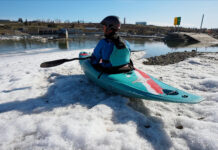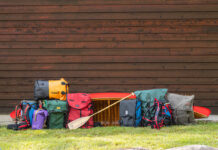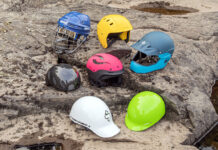Which is better, skeg or rudder—or nothing at all? It’s a popular shore-side debate within the kayaking community, and these hardware options are often a source of confusion for first-time buyers.
Doing it the old-fashioned way
Both skegs and rudders are mechanical aids that allow a kayak’s performance to be altered on the fly, as a paddler reacts and adjusts to conditions. Without a skeg or rudder, the performance of a kayak is solely dependent on its hull shape. The paddler can only modify the hull’s tendency to wander or hold a line by edging and taking strokes to control the boat’s course. While this is a highly active way to paddle, there’s no mechanical steering aid that could go wrong, and there’s a definite purist appeal in doing it all with just your body and paddle.
The con is that paddling without a skeg or rudder can be a lot more demanding, especially over long distances and in wind and waves. Endlessly sweeping on one side or trying to hold a kayak on edge for extended distances can be punishing to the body and inefficient overall.
So what’s the difference between rudder and skeg?
A skeg is a retractable blade that drops out of a slot in the kayak’s stern. The skeg blade cannot pivot from side to side, but is adjustable up and down. It’s typically controlled by a cable and slider. Skegs work by allowing the paddler to fine tune the amount of surface area that the dropped blade presents in the water. By lowering or raising the blade, a kayaker can balance out the forces of wind or current on his boat, allowing the kayak to more easily hold course.
By contrast, a rudder has a blade that pivots side to side, controlled by foot pedals connected to the rudder by cables or line. Most sea kayak rudders can be flipped up out of the water via uphaul and downhaul lines.
A rudder’s advantage is that it allows a paddler to effectively steer the boat by foot, without the need to interrupt or modify the forward stroke. This means that all energy can be poured into driving the kayak forward. The result is a system that maximizes a kayaker’s potential for speed and distance. For this reason, the vast majority of competitive racing designs incorporate rudders.
Which is more reliable?
Many kayakers will argue that skegs are more dependable than rudders, but I haven’t found this to be true. Skegs or rudders can both can suffer mechanical issues and both benefit from routine maintenance and care.
Skegs can be prone to jamming because it’s easy to get a pebble stuck between the skeg blade and box when launching from a beach. However, a little education and restraint with the slider makes this issue a minor one. Be aware that the skeg box does takes up some premium packing space in the stern hatch.
Note that some kayaks are designed to be paddled with the rudder down at all times. While this approach can yield great results, it does mean that if the rudder fails, the hull may not be very neutral or easy to control without the rudder.
Skeg or rudder: the final word
For most of us, paddling is not a competitive pursuit. So try rudders. Try skegs. Try nothing at all. Make the decision based on personal experience, rather than by listening to heated debates you overhear at the launch.









When I first saw the title of this article, I was afraid it was going to be yet another reprint of an article claiming to be the last word in the battle between skegs and rudders. While that article had good information about when and how one might want to use a skeg, and why it works, the author clearly could not get his head around the physics of a rudder (insisting that it was undeniable and should be obvious to anyone that a rudder in the water – at any angle – has the same effect as a fully deployed skeg – when in fact, it should be obvious to anyone that that is hogwash).
So it was refreshing to see an article on the subject that is devoid of misinformation, and it was also refreshing to see someone suggest paddlers choose for themselves what suits their style and preferences.
On the other hand, I think there are a few who liked the detailed information the other article gave about using a skeg, and might also like an equivalent explanation of how a rudder works. Especially since that other article gave misinformation I think needs to be corrected (in the comments, some readers did correct the author, but he dismissed them even though some were speaking from very specifically relevant experience).